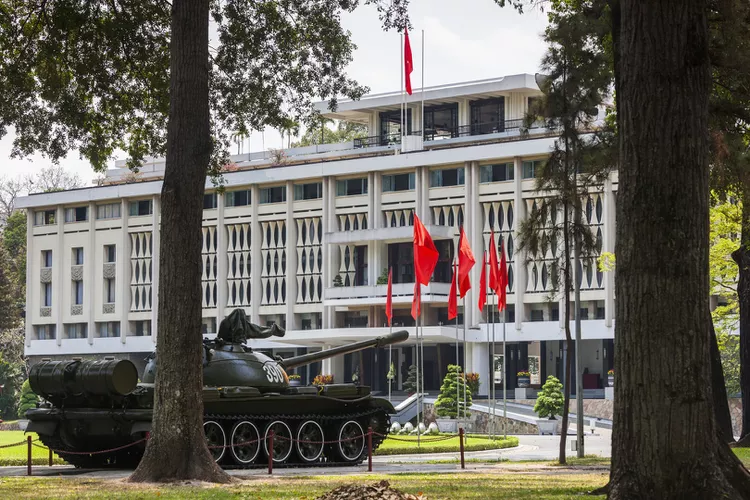Summary
Despite its brief renaming as the Reunification Palace after the fall of Saigon to communists, the Independence Palace now stands with its original name intact.
This government building has a long history that extends to the French occupation in the 19th century. During the Vietnam War, it served as the home and command center of General Nguyen Van Thieu, the head of a military junta who came to power following the assassination of the first President of South Vietnam in 1963.
The Independence Palace was the site of a dramatic conclusion to the Vietnam War as tanks crashed through the main gate on the morning of April 30, 1975.
Today, the Independence Palace serves as a time capsule unchanged since the 1970s—a must-see in Ho Chi Minh City and a significant stop for history enthusiasts touring Vietnam.
How to Find the Independence Palace
The Independence Palace occupies a large green plot in District 1 of Central Saigon. The only entrance for tourists is through the main gate on Nam Ky Khoi Nghia, located on the eastern side of the palace grounds.
From the tourist district of Pham Ngu Lao and Bui Vien, walk east past the large Ben Thanh Market, then turn left and walk north on Nam Ky Khoi Nghia.
Inside the Independence Palace
Attractions within the airy palace interior are fairly minimal. Roped-off rooms, including the presidential office, receiving room, and bedroom, exude a musky and grim atmosphere with antique furniture and bare walls. A highlight is the command bunker located in the basement, which features vintage radio equipment and strategy maps on the walls.
After exiting the basement into the courtyard, visitors will find a room filled with historic photos—heavily infused with propaganda—depicting the fall of the Independence Palace. The photos present the narrative from the victors of the Vietnam War, reflecting a one-sided viewpoint.
A climb to the fourth-floor rooftop reveals impressive views of the palace grounds, as well as an old US UH-1 helicopter. This rooftop served as a helipad for staff evacuations just prior to the palace’s capture.
Before departing, check out two of the original Russian T-54 tanks, used in the capture of the palace, which are parked on the lawn.
History of the Independence Palace
Norodom Palace, the French colonial headquarters in Saigon, was built in 1873 and was occupied by Ngo Dinh Diem, the first president of South Vietnam. This historic structure was bombed during an assassination attempt in 1962, but notably, one of the bombs did not detonate!
Following the damage, President Diem ordered the demolition of the old palace and enlisted the renowned architect Ngo Viet Thu to design a modern replacement.
Tragically, President Diem was assassinated in 1963 before the new palace was completed. General Nguyen Van Thieu, head of a military junta, moved into the finished palace in 1967 and renamed it Independence Palace.
The Independence Palace functioned as the operations center for the South Vietnamese against communist forces until April 21, 1975, when General Thieu was evacuated as part of Operation Frequent Wind—the largest helicopter evacuation in history.
On April 30, 1975, a North Vietnamese tank crashed through the palace gates, which signaled the capture of the palace by Communist forces and the end of the Vietnam War.
Visiting the Independence Palace
Open Hours: Daily from 7:30 a.m. to 4 p.m., with the ticket window closing between 11 a.m. and 1 p.m. The palace may close sporadically for special events or VIP visits.
Entrance Fee: VND 40,000 (approximately US$2), payable at the main gate before entry.
Visitor Dos and Don’ts: All visitors must undergo security screening. Dangerous objects, such as pocketknives, are not permitted. Small backpacks are allowed, but larger luggage must be stored at security. Please refrain from walking on the grass or touching displays around the palace.
Tour Guides
Due to the limited signage and explanations regarding rooms and displays, an English-speaking guide will significantly enhance your experience at the Independence Palace. Free tour guides can be arranged in the lobby, or you may join an already ongoing group.
For further details, it may be beneficial to visit the Independence Palace’s official site.





